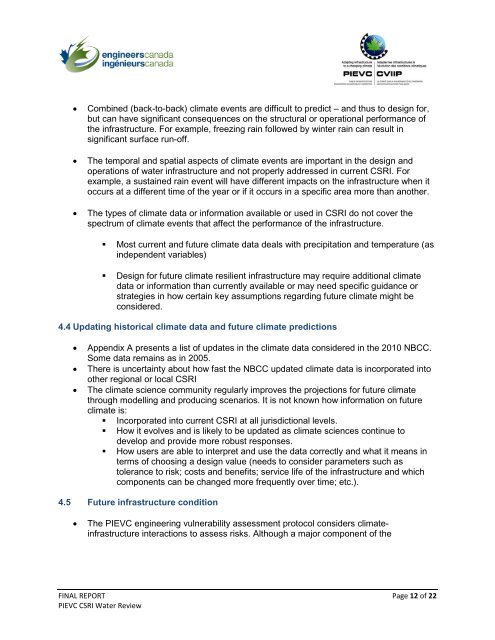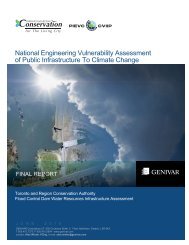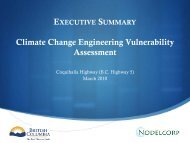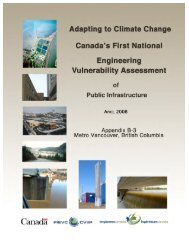Codes, Standards and Related Instruments (CSRI) - Vulnerability ...
Codes, Standards and Related Instruments (CSRI) - Vulnerability ...
Codes, Standards and Related Instruments (CSRI) - Vulnerability ...
You also want an ePaper? Increase the reach of your titles
YUMPU automatically turns print PDFs into web optimized ePapers that Google loves.
• Combined (back-to-back) climate events are difficult to predict – <strong>and</strong> thus to design for,but can have significant consequences on the structural or operational performance ofthe infrastructure. For example, freezing rain followed by winter rain can result insignificant surface run-off.• The temporal <strong>and</strong> spatial aspects of climate events are important in the design <strong>and</strong>operations of water infrastructure <strong>and</strong> not properly addressed in current <strong>CSRI</strong>. Forexample, a sustained rain event will have different impacts on the infrastructure when itoccurs at a different time of the year or if it occurs in a specific area more than another.• The types of climate data or information available or used in <strong>CSRI</strong> do not cover thespectrum of climate events that affect the performance of the infrastructure.• Most current <strong>and</strong> future climate data deals with precipitation <strong>and</strong> temperature (asindependent variables)• Design for future climate resilient infrastructure may require additional climatedata or information than currently available or may need specific guidance orstrategies in how certain key assumptions regarding future climate might beconsidered.4.4 Updating historical climate data <strong>and</strong> future climate predictions• Appendix A presents a list of updates in the climate data considered in the 2010 NBCC.Some data remains as in 2005.• There is uncertainty about how fast the NBCC updated climate data is incorporated intoother regional or local <strong>CSRI</strong>• The climate science community regularly improves the projections for future climatethrough modelling <strong>and</strong> producing scenarios. It is not known how information on futureclimate is:• Incorporated into current <strong>CSRI</strong> at all jurisdictional levels.• How it evolves <strong>and</strong> is likely to be updated as climate sciences continue todevelop <strong>and</strong> provide more robust responses.• How users are able to interpret <strong>and</strong> use the data correctly <strong>and</strong> what it means interms of choosing a design value (needs to consider parameters such astolerance to risk; costs <strong>and</strong> benefits; service life of the infrastructure <strong>and</strong> whichcomponents can be changed more frequently over time; etc.).4.5 Future infrastructure condition• The PIEVC engineering vulnerability assessment protocol considers climateinfrastructureinteractions to assess risks. Although a major component of theFINAL REPORT Page 12 of 22PIEVC <strong>CSRI</strong> Water Review








